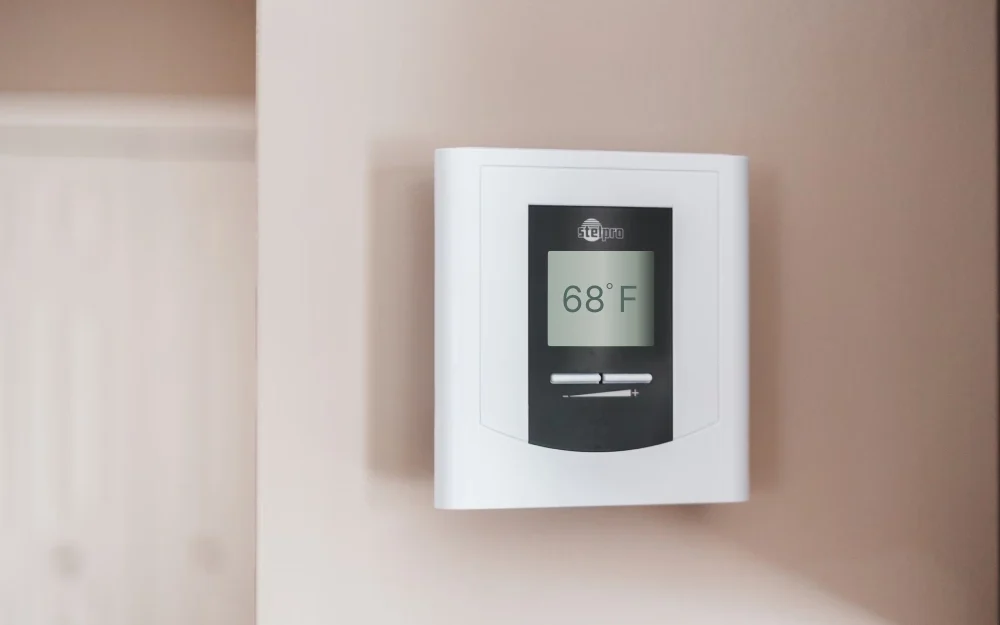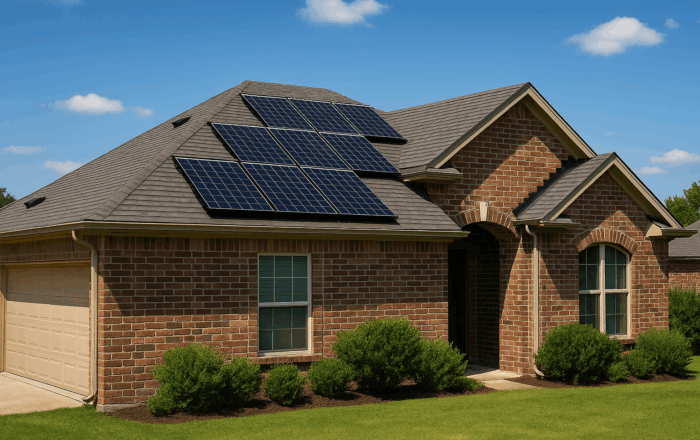Home Improvement Living in Texas
How Many Solar Panels Do You Need in Texas?
4 minute readHow to calculate the number of solar panels you need to power your Texas home
Home > BKV Energy Blog > All Posts > Best Winter Thermostat Settings for Low Energy Bills
What's the best thermostat temperature setting for winter?
7 minute read • Last update November 2025

When temperatures drop during the winter months, using the proper thermostat settings becomes essential. Finding the ideal indoor temperature allows you to stay cozy and control heating costs without breaking the bank with excessive energy bills.
So, what is the best temperature to set a thermostat in winter to save money while also keeping your family warm, happy, and healthy? Let’s find out!
Recommended winter thermostat settings:
According to the Department of Energy, the ideal thermostat setting for winter is around 68°F to 70°F. For most households, this represents a comfortable temperature that balances warmth and energy savings—especially in homes with additional heating system features to help with cost management (more on that a little later!).
While this is a good guideline, there’s not one definitive set-and-forget temperature to set because your needs will vary throughout the day. The World Health Organization recommends keeping indoor temperatures between 64 and 75 degrees for healthy people. But for those who are very young, elderly or who have health problems, the minimum temperature shouldn’t dip below 68.
Alternatively, there’s no point in burning fuel or wasting electricity to maintain a 70°F interior temperature when there’s nobody in the house to feel the benefit. So, when your family is out, the best temperature for a thermostat in winter is lower, typically somewhere between 60°F and 65°F.
Setting a lower temperature at night helps save energy and reduce your heating bill without compromising warmth. So, what’s the best temperature for a heater in winter at night? Just a few degrees lower than daytime is usually fine—aim for temperature settings similar to what you’d use through the day when there’s nobody home.
Of course, if outside temps drop unexpectedly, you may need to readjust, but you can still optimize your thermostat setting for winter to save money. It’s estimated most households can save 1-3% on energy costs for each degree over every eight hours. So, as long as you’re using a colder setting some of the time, you’ll still make savings in the long term.
Best temperature to sleep in
As a rule of thumb, sleep psychologist Michelle Drerup, PsyD, says to keep your bedroom at 60 to 67° F and to think of your bedroom as your ‘cave.’ “It should be cool, dark and quiet to enhance your sleep.” By reducing the temperature at night, you will not only achieve an ideal sleeping temperature but reduce your energy usage as well.
The recommended thermostat settings above are a good starting point for finding the best temperature for your heater in winter. However, there are a few additional factors you’ll need to consider to find the ideal temperature for your unique needs. Let’s take a closer look at some of the other elements that impact comfort and energy efficiency.
What to set your thermostat to in winter will largely depend on where you live. If you’re based in a place with harsh Texas winters, like areas around the panhandle, you’ll likely need a warmer internal temperature to stay comfortable. On the other hand, Texans who enjoy milder winters, like those in central and southern regions, can often set their thermostats to lower temperatures.
Houses with poor insulation lose warmth quickly, forcing heating systems to work harder. If you’re noticing drafts around windows, door jambs, air vents, or walls, this could be a sign that your home insulation needs improvement. So, until you’ve planned your upgrades, you’ll need to set a higher heater temperature in winter to account for heat loss due to inefficiency.
Larger homes require more energy to heat effectively, making it even more essential to find the ideal thermostat setting for winter. One of the best ways to stay warm while still saving energy is to use zoning systems to sustain different temperatures in various rooms. Conversely, smaller homes heat up quicker, meaning it’s usually feasible to set your home’s temperature a few degrees lower than average.
Even when thermostat temperatures remain unchanged, high humidity can make rooms feel warmer, while low humidity can make it feel cooler. Dry air can make your skin feel cold, prompting you to increase your thermostat setting unnecessarily. A humidifier can help improve comfort without adjusting your thermostat above its normal temperature.
Older systems may struggle to keep up with the demands of colder weather, especially if you’ve skipped some routine maintenance checks on your HVAC system. This makes it harder to find the best thermostat setting for winter that balances comfort without increasing your energy bill. We recommend regular inspections of your entire heating and cooling system to ensure optimum efficiency when it gets cold outside.
While understanding what temperature to set a thermostat in winter is essential in avoiding unnecessary expenses, it’s not the only way to save money. Here’s a rundown of the most common errors to avoid.
Jumping the gun and setting your desired temperature without gradually acclimatizing to the changing season is a common mistake. After all, the best setting for a thermostat in winter is unlikely to be your very first adjustment. The solution? Try lowering it by one degree weekly to avoid sudden spikes in energy consumption.
Before turning up your heater, consider a more pragmatic approach. Can you put on a thicker sweater, heavier socks, or thermal leggings? If you can maintain comfortability with a simple wardrobe change it will go a long way in reducing your energy usage / costs.
It’s all too tempting to crank up your heater temperature in winter—just as powering down your air conditioner to its lowest temperature can be appealing during the sweltering Texas summer. However, both strategies will waste energy. That said, there’s also little point in making the entire family uncomfortable by trying to battle through winter on a setting that’s too cold. So, finding a balance is essential.
Humidity is an often-overlooked factor when deciding what thermostat setting for winter is best for your home. The ideal humidity level depends on the season. However, it’s generally agreed that keeping humidity between 30-60% is the best way to enhance comfort while also ensuring energy efficiency in heating and cooling costs throughout the seasons.
Many homeowners forget to adjust thermostat settings when they leave the house, leading to unnecessary energy use. A programmable thermostat allows you to set specific adjustments for when you’re out to ensure your system isn’t working overtime for no reason. If you don’t have a programmable thermostat, you’ll need to manually adjust the temperature before leaving the house.
Space heaters are a quick fix for providing immediate warmth in cold rooms. However, overuse can significantly increase heating costs because they use a lot of electricity and are typically less efficient than a correctly set central heating system. So, they’re best used as a supplementary heat source rather than a substitute for your primary HVAC system.
Modern technology takes the guesswork out of finding the perfect thermostat setting for winter. Whether you choose a programmable or a more advanced smart thermostat, you’ll be assured of automated temperature control, leading to enhanced comfort and improved energy savings. Here’s an overview of both types.
Programmable thermostats allow you to set a schedule based on when you’re home, out, and sleeping. For example, you could set it to 62°F during the day while you’re at work, raise it to 70°F right before you come home, and back down to 65°F when you go to bed. It’s estimated that installing a programmable thermostat could save up to 10% annually on your energy bill.
Smart thermostats take the concept of a programmable thermostat even further by learning your schedule and preferences and adjusting your home’s temperature without you needing to set anything manually. Most models even allow remote access via a smartphone app, making it easy to adjust indoor temperature from anywhere. Estimated savings are around 8% annually.
To get your home in the ideal temperature range during winter, it’s crucial to choose the right spot for your thermostat. Steer clear of the following areas to get the most accurate temperature readings:
Q: What is the best temperature for my heater in winter?
A: According to the Department of Energy, the ideal thermostat setting for winter is around 68°F.
Q: What temperature is best to sleep in?
A: Michelle Drerup, PsyD, says to keep your bedroom at 60 to 67° F.
Q: What temperature is too cold for a house?
A: According to the World Health Organization a house temperature below 64 degrees can be harmful to health with prolonged exposure.
Q: Is it more efficient to maintain temperature?
A: It’s better to adjust your thermostat based on time of day such as lowering it to 68 degrees when you go to sleep or down to 65 degrees when you leave your home for work.
With the colder weather comes higher heating costs. That’s mostly unavoidable. However, there are plenty of simple adjustments you can make to keep energy use under control without sacrificing comfort. We’ve already covered the basics, but here are some additional tips to help you save money on your electricity bill this winter:
By making these small, strategic adjustments, you can more easily keep your family warm and your energy costs manageable this winter.
Even with the right thermostat setting for winter, choosing an affordable electricity plan is essential.
At BKVE, we’re committed to offering tailored solutions to meet the needs and budgets of all Texans so households across the state can enjoy year-round comfort without breaking the bank. For example, our gimmick-free Bluebonnet plan could save you $800 or more per year!
Explore our plans today and take control of your energy usage while staying warm and cozy this winter!
Graham Lumley, Digital Marketing Manager at BKV Energy, leads digital and traditional marketing strategies, focusing on educating Texans about the state's deregulated energy market. With over 8 years of marketing experience, he creates content to help consumers understand and save on their energy bills, bringing a fresh and dynamic approach to the industry.

Home Improvement Living in Texas
How to calculate the number of solar panels you need to power your Texas home

Gardening in Texas presents unique challenges. Long, hot summers and frequent droughts mean that traditional landscaping often requires significant water
Get $50 off your electric bill!
Use code BKVEJOINUS50
Enter your zip code to shop BKV Energy's affordable, fixed-rate Texas electricity plans. Use the promo code for $50 off your electric bill.